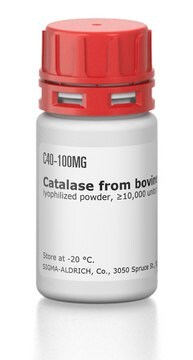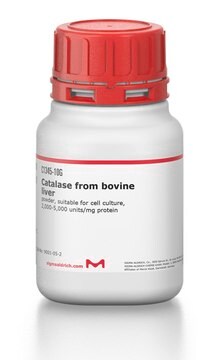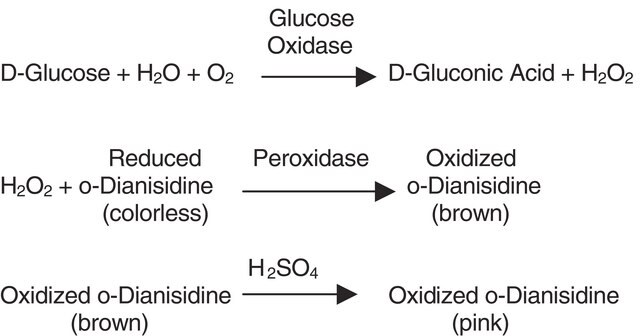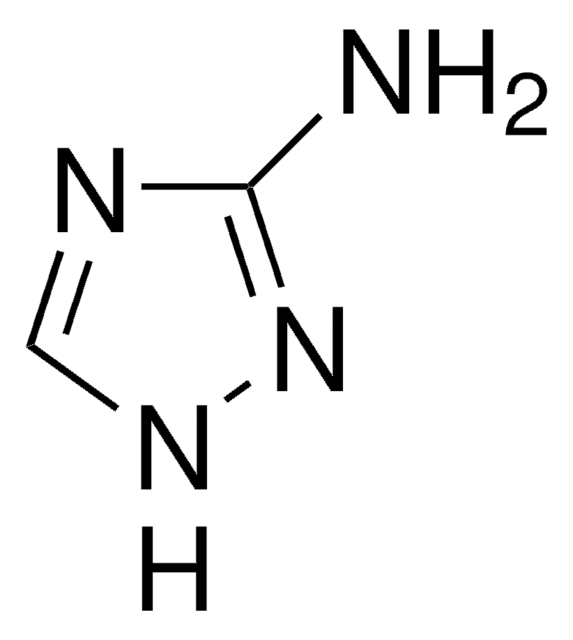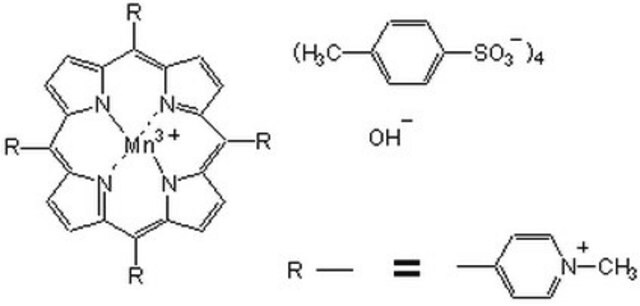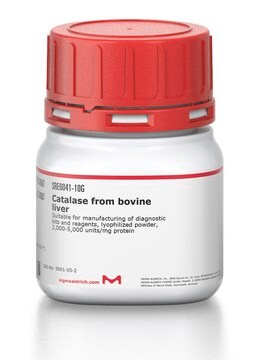C4963
Catalase−polyethylene glycol
lyophilized powder, ~40,000 units/mg protein
Synonyme(s) :
PEG-Catalase
Se connecterpour consulter vos tarifs contractuels et ceux de votre entreprise/organisme
About This Item
Produits recommandés
Forme
lyophilized powder
Niveau de qualité
Activité spécifique
~40,000 units/mg protein
Poids mol.
PEG 5,000
Composition
Protein, ~50% E405
Ampleur du marquage
~40 mol PEG per mol protein
Fixation de matrice
secondary amine linkage.
Température de stockage
−20°C
Vous recherchez des produits similaires ? Visite Guide de comparaison des produits
Application
Pulmonary artery endothelial cells treated with PEG-catalase showed effective inhibition of 20- HETE (hydroxyeicosatetraenoic acid)-induced increase in fluorescence. However, the experiment excludes potential nonspecific fluorescence of DCF (dichlorofluorescein). This experiment studied the effect of 20-HETE on superoxide production and NADPH oxidase activation.
Actions biochimiques/physiologiques
Catalase from bovine liver catalyzes the decomposition of H2O2 into water and oxygen. It is a tetramer consisting of four equal subunits with a molecular weight of 60 kDa each. Each subunit contains iron bound to a protoheme IX group. The enzyme also strongly binds NADP, which is in close proximity to the heme group. Catalase activity is constant over the pH range of 4.0-8.5. The pI is found to be 5.4. The enzyme activity is inhibited by 3-amino-1-H-1,2,4 triazole, cyanide, azide, hydroxylamine, cyanogen bromide, 2-mercaptoethanol, dithiothreitol, dianisidine, and nitrate. Incubation of catalase with ascorbate or ascorbate/Cu2+ results in degradation of the catalase molecule. It does not require any activators.
Conditionnement
Package size based on protein content
Autres remarques
Catalase from bovine liver coupled to methoxy-polyethylene glycol.
Forme physique
Contains PEG plus 5% citrate buffer salts
Code de la classe de stockage
11 - Combustible Solids
Classe de danger pour l'eau (WGK)
WGK 3
Point d'éclair (°F)
Not applicable
Point d'éclair (°C)
Not applicable
Équipement de protection individuelle
Eyeshields, Gloves, type N95 (US)
Faites votre choix parmi les versions les plus récentes :
Déjà en possession de ce produit ?
Retrouvez la documentation relative aux produits que vous avez récemment achetés dans la Bibliothèque de documents.
Les clients ont également consulté
Joe Nassour et al.
Nature communications, 7, 10399-10399 (2016-01-30)
The main characteristic of senescence is its stability which relies on the persistence of DNA damage. We show that unlike fibroblasts, senescent epithelial cells do not activate an ATM-or ATR-dependent DNA damage response (DDR), but accumulate oxidative-stress-induced DNA single-strand breaks
Jeremiah D Keyes et al.
Free radical biology & medicine, 112, 534-543 (2017-08-28)
ERK-dependent signaling is key to many pathways through which extracellular signals are transduced into cell-fate decisions. One conundrum is the way in which disparate signals induce specific responses through a common, ERK-dependent kinase cascade. While studies have revealed intricate ways
Emeric Deruy et al.
PloS one, 5(9), e12712-e12712 (2010-09-22)
Senescence is a state of growth arrest resulting mainly from telomere attrition and oxidative stress. It ultimately leads to cell death. We have previously shown that, in keratinocytes, senescence is induced by NF-kappaB activation, MnSOD upregulation and H(2)O(2) overproduction. We
Kathleen D Metzler et al.
Cell reports, 8(3), 883-896 (2014-07-30)
Neutrophils contain granules loaded with antimicrobial proteins and are regarded as impermeable organelles that deliver cargo via membrane fusion. However, during the formation of neutrophil extracellular traps (NETs), neutrophil elastase (NE) translocates from the granules to the nucleus via an
Puvi N Seshiah et al.
Circulation research, 91(5), 406-413 (2002-09-07)
Angiotensin II (Ang II)-stimulated hypertrophy of vascular smooth muscle cells is mediated by reactive oxygen species (ROS) derived from NAD(P)H oxidases. The upstream signaling mechanisms by which Ang II activates these oxidases are unclear but may include protein kinase C
Notre équipe de scientifiques dispose d'une expérience dans tous les secteurs de la recherche, notamment en sciences de la vie, science des matériaux, synthèse chimique, chromatographie, analyse et dans de nombreux autres domaines..
Contacter notre Service technique
